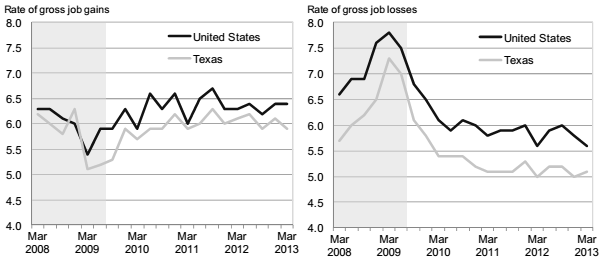Impact of Gross Job Losses
| ✅ Paper Type: Free Essay | ✅ Subject: Economics |
| ✅ Wordcount: 860 words | ✅ Published: 29 Aug 2017 |
Task 1
Changes in the number of jobs are the net result of decreases or increases in the employment opportunities that are available in all sectors of the economy. The role of Business Employment Dynamics (BED) reports is to track and report such changes within private business establishments. Gross job gains result from the increases in employment opportunities that result from the expansion of existing establishments or the creation of new businesses while gross job losses result from employment contractions. Net change is the difference between the two measures.
Gross job losses in private sector establishments totaled 465,576 within the state of Texas between December 2012 and March 2013 (Bureau of Labor Statistics, 2014). Stanley W. Suchman, the Regional Commissioner, opined that the total job losses had increased by 15,218 when compared to the previous quarter. In contrast, gross job gains of about 537,115 were experienced in the first quarter of 2013 (Ryan, 2013).
It is observed that the number of gross job gains had been increasing since June, 2009 when they had reached an all-time low of about 435,900 (Dickerson, 2014). After gross job losses had declined the last quarter, they rose by 15,218 in the three months that ended in March 2013 (Bureau of Labor Statistics, 2014). The highest number of job losses was witnessed in March 2009 when over 620,000 jobs were lost during that quarter.
Figure 1: Gross Job Losses and Gains in Texas’ Private Sector between March 2008 and March 2013
Source: Bureau of Labor Statistics (2014).
Gross job gains in Texas represented about 5.9% of the total number of people that were employed within the private sector in the first quarter of 2013. Additionally, gross job gains were responsible for about 6.4% of private employment within all American states. The trend of job gains in Texas has been below the nation’s rate since March 2009. Additionally, the 5.1% rate of the state’s gross job loss in the private sector was lower than America’s rate of 5.6%, in March 2013 (Bureau of Labor Statistics, 2014). The trend of gross job loss in Texas has remained below America’s national rate since the inception of the series in September 1992.
Figure 2: Private Sector, Gross Job Losses and Gaines as a Percentage of Employment: Texas and United States (between March 2008 and March 2013)

Source: Bureau of Labor Statistics (2014).
In its first quarter of 2013, the state’s gross job gains exceeded job losses in most industry sectors. For instance, expanding and opening establishments in professional as well as business services created over 105,000-employment opportunities during the period. However, about 92,000 jobs were lost due to closing and contracting establishments (Ryan, 2013). The net gain of about 13,056 jobs in the professional and business services sectors was the largest when compared to other sectors. The leisure and hospitality as well as the construction sectors, also showed significant net job gains. The construction sector, for example, created over 56,000 through the expansion and creation of new establishments. Conversely, they were neutralized by the loss of about 44,000 jobs at contracting and closing establishments, which led to a net gain of about 11,633 jobs (Merrill, 2014). The hospitality sector and leisure experienced a net employment gain of about 12,000 workers that resulted from 85,000 gross job gains that were created through the expansion and creation of new establishments. However, about 73,000 jobs were lost; as a result, of contracting and the closure of existing establishments (Dickerson, 2014).
Why the State’s Experiences are Different from the rest of the Nation
According to the Bureau of Labor Statistics (2014), administrative changes affected BED statistics significantly. For instance, administrative changes affected the number of establishments in the health services. An assessment of the administrative information that forms the basis of the BED data showed that a number of establishments that offered home-based had been wrongfully classified in the private household sector (Ryan, 2013). The non-economic industry code change, inadvertently inflated the data that represented gross job gains, births, openings, as well as net employment change in various data series, including state’s total private, national total private, the health services and education sector, as well as firm size class.
Task 2
Statement A
The woman continued making significant contributions to economic growth because she was still charging other clients for the investment advice offered through her website. However, her spouse was excluded from her contributions because she gave him free investment advice. Therefore, the GDP was impacted negatively.
Statement B
Economic growth and GDP declined because the amateur player did not receive payment and, the tournament sponsor failed to release the prize money. As a result, no funds were channeled to the economy, to support growth.
Statement C
The rate of economic growth had no change or GDP because of the failure to indicate that the installation of the equipment would generate additional revenue. Economic growth would have been experienced if the public utility company transferred the cost of the installation to its clients. However, that fact was not stated.
References
Bureau of Labor Statistics. (2014). Business employment dynamics in Texas – March2013. Retrieved from http://www.bls.gov/ro6/fax/bed_tx.htm
Dickerson, M. (2014). Homeownership and America’s financial underclass: Flawed premises,broken premises, new prescriptions. Cambridge: Cambridge University Press.
Merrill, D. (2014). America in decline. Indiana: Xlibris Corporation.
Ryan, M. (2013). State profiles in 2013: The population and economy of each U.S. state.Pennsylvania: Bernan Press.
Cite This Work
To export a reference to this article please select a referencing stye below:
Related Services
View allDMCA / Removal Request
If you are the original writer of this essay and no longer wish to have your work published on UKEssays.com then please click the following link to email our support team:
Request essay removal


